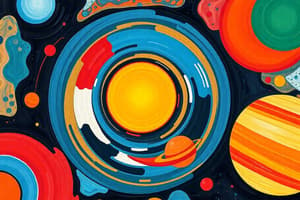Podcast
Questions and Answers
What makes up over 99% of the mass of the solar system?
What makes up over 99% of the mass of the solar system?
- The moons
- The planets
- The sun (correct)
- The asteroids
Which planet is known for its beautiful rings made of ice particles, rocks, and dust?
Which planet is known for its beautiful rings made of ice particles, rocks, and dust?
- Neptune
- Jupiter
- Uranus
- Saturn (correct)
Which planet is covered in blue methane clouds?
Which planet is covered in blue methane clouds?
- Venus
- Uranus
- Neptune (correct)
- Jupiter
Which planet has the smallest mass in the solar system?
Which planet has the smallest mass in the solar system?
Which planet is described as Earth's sister planet?
Which planet is described as Earth's sister planet?
Which planet has a thin atmosphere?
Which planet has a thin atmosphere?
Welke planeet heeft de snelste omlooptijd om de zon?
Welke planeet heeft de snelste omlooptijd om de zon?
Wat is de belangrijkste oorzaak dat de planeten op hun plek blijven in het zonnestelsel?
Wat is de belangrijkste oorzaak dat de planeten op hun plek blijven in het zonnestelsel?
Hoeveel manen heeft de planeet Jupiter volgens de tekst?
Hoeveel manen heeft de planeet Jupiter volgens de tekst?
Welke planeet staat bekend om haar dikke atmosfeer van koolstofdioxide en zwavelzuurwolken?
Welke planeet staat bekend om haar dikke atmosfeer van koolstofdioxide en zwavelzuurwolken?
Wat is volgens de tekst de afstand tussen de zon en de aarde?
Wat is volgens de tekst de afstand tussen de zon en de aarde?
Flashcards are hidden until you start studying
Study Notes
- Solar system is centered around the sun, which makes up over 99% of its mass.
- The planets in the solar system make up less than one quarter of a percent of its mass.
- The sun's gravity keeps the planets in orbit and provides heat and light crucial for life on Earth.
- Mercury is the smallest planet, closest to the sun, with extreme temperatures and no moons.
- Venus is Earth's sister planet, extremely hot with a thick carbon dioxide atmosphere and sulfuric acid clouds.
- Mars is the red planet with a thin atmosphere, water ice, and two small irregular moons.
- Jupiter is the largest planet, a gas giant with at least 67 moons, including some as large as Mercury.
- Saturn is known for its beautiful rings made of ice particles, rocks, and dust, with over sixty moons.
- Uranus spins sideways, has rings and 27 moons, covered in blue methane clouds.
- Neptune is a dark blue gas giant with methane in its atmosphere, having thin rings and 14 moons.
- Pluto was declared a dwarf planet in 2006 due to its small size compared to other planets.
Studying That Suits You
Use AI to generate personalized quizzes and flashcards to suit your learning preferences.




